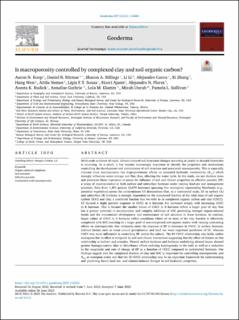| dc.identifier.citation | Koop, A. N., Hirmas, D. R., Billings, S. A., Li, L., Cueva, A., Zhang, X., Wen, H., Nemes, A., Souza, L. F. T., Ajami, H., Flores, A. N., Rudick, A. K., Guthrie, A., Klamm, L. M., Unruh, M., & Sullivan, P. L. (2023). Is macroporosity controlled by complexed clay and soil organic carbon? Geoderma, 437, 116565. | en_US |
| dc.description.abstract | Multi-scale evidence of rapid, climate-induced soil structural changes occurring at yearly to decadal timescales is mounting. As a result, it has become increasingly important to identify the properties and mechanisms controlling the development and maintenance of soil structure and associated macroporosity. This is especially relevant since macroporosity has disproportionate effects on saturated hydraulic conductivity ( ) which strongly influences water storage and flux, thus, affecting the water cycle. In this study, we use decision trees and piecewise linear regression to assess the influence of soil and climate properties on effective porosity (EP; a proxy of macroporosity) in both surface and subsurface horizons under varying land-use and management practices. Data from 1,491 pedons (3,679 horizons) spanning five ecoregions representing bioclimate (e.g., potential vegetation) across the conterminous US demonstrate that, at a continental scale, EP in surface (A) and subsurface (B) horizons is strongly dependent on the complexed fraction of the total mass of soil organic carbon (SOC) and clay; a combined fraction that we refer to as complexed organic carbon and clay (COCC). EP showed a slight positive response to COCC in A horizons but increased steeply with increasing COCC in B horizons. This is because the smaller values of COCC in B horizons reflect a larger pool of clay that has a greater potential to accommodate and complex additions of SOC promoting stronger organo-mineral bonds and the concomitant development and maintenance of soil structure in these horizons. In contrast, larger values of COCC in A horizons reflect conditions where all or most of the clay fraction is effectively complexed with SOC resulting in a larger pool of non-complexed soil organic matter with varying contrasting effects on macroporosity that ultimately mute the response of EP to increases in COCC. In surface horizons, indirect factors such as mean annual precipitation and land use were important predictors of EP, whereas COCC was more influential in controlling EP within the subsoil. The EP-COCC relationship also holds within ecoregions but its effect is mitigated by soil and climate interactions suggesting that the effect of climate on this relationship is indirect and complex. Plowed surface horizons and horizons underlying plowed layers showed greater homogenization (due to disturbance effects reducing heterogeneity in the soil) as well as a reduction in the magnitude and rate of change of EP as a function of COCC compared to undisturbed horizons. Our findings suggest that the complexed fraction of clay and SOC is important for controlling macroporosity and at ecoregion scales and that the EP-COCC relationship may be an important framework for understanding and predicting future land use- and climate-induced changes in soil hydraulic properties. | en_US |

